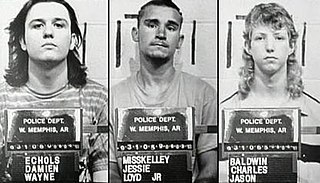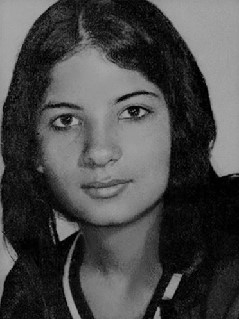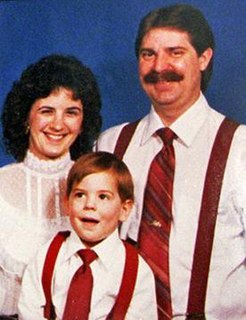Related Research Articles

The West Memphis Three are three men convicted as teenagers in 1994 of the 1993 murders of three boys in West Memphis, Arkansas, United States. Damien Echols was sentenced to death, Jessie Misskelley Jr. to life imprisonment plus two 20-year sentences, and Jason Baldwin to life imprisonment. During the trial, the prosecution asserted that the juveniles killed the children as part of a Satanic ritual.

The Lake Bodom murders is one of the most infamous unsolved homicide cases in Finnish criminal history. On 5 June 1960, at Bodom Lake, 15-year-old girls Maila Björklund and Anja Mäki and 18-year-old man Seppo Boisman were killed by stabbing and blunt-force trauma to their heads, while sleeping inside a tent. The fourth youth, Nils Gustafsson, then 18 years old, was found outside the tent with broken facial bones and stab wounds. Despite extensive investigations, the perpetrator was never identified and various theories on the killer's identity have been presented over the years. Gustafsson was unexpectedly arrested on suspicion of committing the murders in 2004, but he was found not guilty the following year.
The Toronto hospital baby deaths, still imagined by some to be homicides, occurred in the Cardiac ward of the Hospital for Sick Children between July 1980 and March 1981. They started when a cardiology ward was split up and moved to two new adjacent wards. They ended when the police were called in and the digitalis-type medication possibly used for the alleged killings (digoxin) began to be kept under lock and key. Three nurses were at the centre of the investigation, and an apparent attempt to poison nurses' food. One of the nurses, Susan Nelles, was charged with four murders, but the prosecution was dismissed a year later on the grounds that she could not have been responsible for a death not included in the indictment, which the judge deemed a murder.
The Wanda Beach Murders, sometimes referred to simply as "Wanda", is the case of the unsolved murders of Marianne Schmidt and Christine Sharrock at Wanda Beach near Cronulla in Sydney, New South Wales, Australia, on 11 January 1965. The victims, both aged 15, were best friends and neighbours from the suburb of West Ryde, and their partially buried bodies were discovered the next day. The brutal nature of the slayings and the fact that they occurred on a deserted, windswept beach brought massive publicity to the case. By April 1966, police had interviewed some 7,000 people, making it the largest investigation in Australian history. It remains one of the most infamous unsolved Australian murder cases of the 1960s, and New South Wales' oldest unsolved homicide case.
Jonathan Paul Luna was an American lawyer found dead under mysterious circumstances in Lancaster County, Pennsylvania while serving as an Assistant United States Attorney in Baltimore, Maryland. Luna had been stabbed 36 times with his own pocketknife and then drowned in a creek next to his car in rural Lancaster County. Investigations have proven inconclusive, and there is debate on whether Luna's death was murder or suicide.
The Clinton Chronicles: An Investigation into the Alleged Criminal Activities of Bill Clinton is a 1994 documentary that accused Bill Clinton of a range of crimes. The claims in the video are controversial; some have been discredited, while others continue to be debated. The philandering and sexual harassment claims in the film have since been reported, and in some cases confirmed, by mainstream media. Years after the film was released, Clinton paid an out-of-court settlement to resolve the accusations made by Paula Jones in the movie.
The "Connecticut River Valley Killer" refers to an American unidentified serial killer believed to be responsible for a series of stabbing murders mostly in and around Claremont, New Hampshire and the Connecticut River Valley, primarily in the 1980s.
The New Bedford Highway Killer is an unidentified serial killer responsible for the deaths of at least nine women and the disappearances of two additional women in New Bedford, Massachusetts, between March 1988 and April 1989. The killer is also suspected to have assaulted numerous other women. All the killer's victims were known sex workers or had struggles with addiction. While the victims were taken from New Bedford, they were all found in different surrounding towns, including Dartmouth, Freetown and Westport, Massachusetts, along Route 140. The main detective that pursued the case was John Dextradeur.
A triple homicide was committed in Waltham, Massachusetts, in the United States, on the evening of September 11, 2011. Brendan Mess, Erik Weissman, and Raphael Teken were murdered in Mess's apartment. All had their throats slit with such great force that they were nearly decapitated. Thousands of dollars' worth of marijuana and money were left covering their mutilated bodies; in all, $5,000 was left in the apartment. The local district attorney said that it appeared that the killer and the victims knew each other, and that the murders were not random.

Jeannette DePalma was an American teenager who is believed to have been murdered sometime on or around August 7, 1972 in Springfield Township, Union County, New Jersey, United States.
David Wellington Reed was a 13-year-old boy in the seventh grade at Schuylkill Haven Area Middle School, who was murdered in 1985 by then 20-year-old Joseph "Joe" Geiger in Schuylkill Haven, Pennsylvania, United States over Geiger's stolen illegally grown cannabis plants. Geiger blamed Reed for the disappearance of the drug. Friends, family, and teachers remember Reed as an outgoing person who aspired to fly.

On the evening of November 18, 1987, police went to the mobile home of Russell Keith Dardeen, 29, and his family outside Ina, Illinois, United States, after he had failed to show up for work that day. There, they found the bodies of his wife and son, both brutally beaten. Ruby Elaine Dardeen, 30, who had been pregnant with the couple's daughter, had been beaten so badly she had gone into labor, and the killer or killers had also beaten the newborn to death.
Ellen Rae Greenberg was a 27-year-old first grade teacher at Juniata Park Academy in Philadelphia, Pennsylvania. Ellen, an only child, was born in New York City, New York to Joshua (Josh) and Sandra (Sandee) Greenberg.
On May 1, 2004, the body of Alonzo Brooks was found in La Cygne, Kansas, about a month after he was reported missing after April 3, 2004. The circumstances surrounding Brooks's death are mysterious, and the Federal Bureau of Investigation continues to investigate whether or not he was a victim of a hate crime. On April 5, 2021, the FBI announced that their investigation had proved that Brooks‘s death was a homicide.
The Little Rock serial stabbings refers to a series of seemingly random stabbings that occurred from 2020 to 2021 in Little Rock, Arkansas, during which a total of four people were stabbed, three of them fatally. The local police department later revealed that a single suspect, a possible serial killer, was linked to the incidents via CCTV footage, but has not been apprehended so far.
References
- ↑ "Vigils held at Capitol, courthouse 25 years after Ives, Henry deaths - The Saline Courier". www.bentoncourier.com. Archived from the original on 2019-05-27. Retrieved 2019-05-21.
- ↑ "Arkansas mom's motion in bid to unseal files says DEA hiding crimes". Arkansas Online. 18 August 2018.
- ↑ Berry, Cody Lynn. "Kevin Ives and Don Henry (Murder of)." Encyclopedia of Arkansas, February 26, 2018.
- ↑ KATV (13 August 2018). "Judge orders agencies to review more information in 'Boys on the Tracks' FOIA lawsuit". KATV.
- ↑ Day, Chris. “Train Deaths Are Officially Homicides.” Arkansas Gazette, March 6, 1988, p. 3B.
- ↑ "The Mysterious Deaths of Don Henry & Kevin Ives".
- ↑ "New Witness? Man Claims to Have Seen "Boys on the Tracks" Murders". KARK. 14 February 2018.
- ↑ "Kevin Ives and Don Henry". www.idfiles.com.
- ↑ "The Train Deaths". 21 February 2005. Archived from the original on 21 February 2005.
- ↑ "Former Prosecutor Dan Harmon Arrested". www.mysaline.com. 18 February 2010. Retrieved 2019-06-21.
- ↑ [Arkansas gravestones.org/view.php?id=1133087 "The-Grave-of-Lionel-Keith-McKaskle"].
{{cite web}}: Check|url=value (help) - ↑ "The Mysterious Deaths of Don Henry & Kevin Ives". Unsolved Mysteries. Retrieved 2021-02-14.
- ↑ "Murder on the Tracks - The Massive Cover-up of Kevin Ives and Don Henry". YouTube. Retrieved 2022-06-06.
- ↑ "The Boys on the Tracks." Encyclopedia of Arkansas.